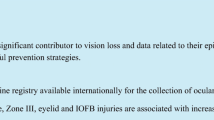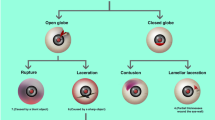Abstract
Purpose
To evaluate the factors influencing final visual outcome after surgical repair of open globe injuries (OGIs) and to correlate the Ocular Trauma Score (OTS) system.
Methods
Prospective cross-sectional study of patients with OGIs from International Globe and Adnexal Trauma Epidemiology Study (IGATES) database at a tertiary referral eye centre in Central India over 2 years. Pre-operative factors affecting final visual outcome and correlation with OTS were evaluated.
Results
208 patients had ocular trauma, of which data from 42 eyes with OGIs were reviewed. The majority of the patients were men (32, 76.2%) below the age of 40 (31, 73.8%). Patients were followed up for at least 6 months. Initial visual acuity (VA) was ≥ 20/40; 2 (4.8%), 20/200 to 20/50; 2 (4.8%), 1/200 to 19/200; 7 (16.7%), LP to HM; 26 (61.9%) and NLP (5, 11.9%). Final VA was ≥ 20/40; 1 (2.4%), 20/50 to 20/200; 8 (19.1%), 1/200 to 19/200; 9 (21.4%), LP to HM; 17 (40.5%) and NLP; 7 (16.7%). Univariate analysis of pre-operative variables showed initial VA (p = 0.0004), presence of hyphaema (p = 0.0323), laceration involving cornea visual axis (p = 0.0192) and retinal detachment (p = 0.0299) were significant prognostic factors in final visual outcome. OTS in our study does not fully correlate with international OTS system.
Conclusions
Initial VA, hyphaema, visual-axis involving cornea laceration and retinal detachment are significant prognostic factors in OGIs. OTS remains a largely effective tool in counselling trauma patients.


Similar content being viewed by others
References
Ramirez DA, Porco TC, Lietman TM, Keenan JD (2018) Ocular injury in United States emergency departments: seasonality and annual trends estimated from a nationally representative dataset. Am J Ophthalmol 191:149–155. https://doi.org/10.1016/j.ajo.2018.04.020
Gilbert CM, Soong HK, Hirst LW (1987) A two-year prospective study of penetrating ocular trauma at the Wilmer Ophthalmological Institute. Ann Ophthalmol 19:104–106
Wong TY, Tielsch JM (1999) A population-based study on the incidence of severe ocular trauma in Singapore. Am J Ophthalmol 128:345–351. https://doi.org/10.1016/s0002-9394(99)00167-1
Krishnaiah S, Nirmalan PK, Shamanna BR, Srinivas M, Rao GN, Thomas R (2006) Ocular trauma in a rural population of southern India: the Andhra Pradesh eye disease study. Ophthalmol 113:1159–1164. https://doi.org/10.1016/j.ophtha.2006.02.020
Nirmalan PK, Katz J, Tielsch JM et al (2004) Ocular trauma in a rural south Indian population: the Aravind comprehensive eye survey. Ophthalmol 111:1778–1781. https://doi.org/10.1016/j.ophtha.2004.02.012
Dandona L, Dandona R, Srinivas M et al (2000) Ocular trauma in an urban population in southern India: the Andhra Pradesh eye disease study. Clin Experiment Ophthalmol 28:350–356. https://doi.org/10.1046/j.1442-9071.2000.00334.x
Kuhn F, Morris R, Witherspoon CD (2002) Birmingham Eye Trauma Terminology (BETT): terminology and classification of mechanical eye injuries. Ophthalmol Clin North Am 27(2):206–210. https://doi.org/10.1016/10.1016/s0896-1549(02)00004-4
Kuhn F, Maisiak R, Mann L, Mester V, Morris R, Witherspoon CD (2002) The ocular trauma score (OTS). Ophthalmol Clin North Am 15:163–165. https://doi.org/10.1016/s0896-1549(02)00007-x
Kumar N, Shekhar C, Kumar P, Kundu AS (2007) Kuppuswamy’s socioeconomic status scale-updating for 2007. Indian J Pediatr 74:1131–1132
Pieramici DJ, Sternberg P, Aaberg TM et al (1997) A system for classifying mechanical injuries of the eye (globe). The ocular trauma classification group. Am J Ophthalmol 123:820–831. https://doi.org/10.1016/s0002-9394(14)71132-8
Colby K (1999) Management of open globe injuries. Int Ophthalmol Clin 39(1):59–69. https://doi.org/10.1097/00004397-199903910-00008
Agrawal R, Shah M, Mireskandari K, Yong GK (2013) Controversies in ocular trauma classification and management: review. Int Ophthalmol 33:435–445. https://doi.org/10.1007/s10792-012-9698-y
Mittra RA, Mieler WF (1999) Controversies in the management of open-globe injuries involving the posterior segment. Surv Ophthalmol 44(3):215–225. https://doi.org/10.1016/s0039-6257(99)00104-6
R Core Team (2013) R: a language and environment for statistical computing. r foundation for statistical computing, Vienna, Austria. https://www.R-project.org
Bull N (2007) Mandatory use of eye protection prevents eye injuries in the metal industry. Occup Med-Oxford 57:605–606. https://doi.org/10.1093/occmed/kqm083
Dain SJ (2016) Sports eyewear protective standards. Clin Exp Optom 99:4–23. https://doi.org/10.1111/cxo.12349
Lipscomb HJ (2000) Effectiveness of interventions to prevent work-related eye injuries. Am J Prev Med 18(Suppl):27–32. https://doi.org/10.1016/s0749-3797(00)00138-0
Yucel OE, Demir S, Niyaz L, Sayin O, Gul A, Ariturk N (2016) Clinical characteristics and prognostic factors of scleral rupture due to blunt ocular trauma. Eye (Lond) 30(12):1606–1613. https://doi.org/10.1038/eye.2016.194
Rofail M, Lee GA, O'Rourke P (2006) Prognostic indicators for open globe injury. Clin Exp Ophthalmol 34(8):783–786. https://doi.org/10.1111/j.1442-9071.2006.01309.x
Yalcin TO, Tok L, Eraslan E, Ozkaya D, Ornek F, Bardak Y (2011) Prognostic factors influencing final visual acuity in open globe injuries. J Trauma 71(6):1794–1800. https://doi.org/10.1097/TA.0b013e31822b46af
Agrawal R, Rao G, Naigaonkar R, Ou X, Desai S (2011) Prognostic factors for vision outcome after surgical repair of open globe injuries. Indian J Ophthalmol 59:465–470. https://doi.org/10.4103/0301-4738.86314
Singh S, Sharma B, Kumar K, Dubey A, Ahirwar K (2017) Epidemiology, clinical profile and factors, predicting final visual outcome of pediatric ocular trauma in a tertiary eye care center of central India. Indian J Ophthalmol 65(11):1192–1197. https://doi.org/10.4103/ijo.IJO_375_17
Agrawal R, Wei HS, Teoh S (2013) Prognostic factors for open globe injuries and correlation of ocular trauma score at a tertiary referral eye care centre in Singapore. Indian J Ophthalmol 61(9):502. https://doi.org/10.4103/0301-4738.119436
Guven S, Durukan A, Erdurman C, Kucukevcilioglu M (2018) Prognostic factors for open-globe injuries: variables for poor visual outcome. Eye 33(3):392–397. https://doi.org/10.1038/s41433-018-0218-9
Lee CH, Lee L, Kao LY, Lin KK, Yang ML (2009) Prognostic indicators of open globe injuries in children. Am J Emerg Med 27(5):530–535. https://doi.org/10.1016/j.ajem.2008.04.004
Rahman I, Maino A, Devadason D, Leatherbarrow B (2006) Open globe injuries: factors predictive of poor outcome. Eye (Lond) 20:1336–1341. https://doi.org/10.1038/sj.eye.6702099
Pieramici DJ, Au Eong K, Sternberg PJ, Marsh MJ (2003) The prognostic significance of a system for classifying mechanical injuries of the eye (globe) in open globe injuries. J Trauma 54:790–794. https://doi.org/10.1097/01.TA.0000047053.53821.C8
Cruvinel IDL, Ghanem VC, Nascimento MA, Torigoe M, Kara-Jose N (2003) Prognostic factors in open globe injuries. Ophthalmologica 217:431–435. https://doi.org/10.1159/000073075
Meng Y, Yan H (2015) Prognostic factors for open globe injuries and correlation of ocular trauma score in Tianjin. China J Ophthalmol. https://doi.org/10.1155/2015/345764
Bunting H, Stephens D, Mireskandari K (2013) Prediction of visual outcomes after open globe injury in children: a 17-year Canadian experience. J AAPOS 17:43–48. https://doi.org/10.1016/j.jaapos.2012.10.012
Feng K, Hu YT, Ma Z (2011) Prognostic indicators for no light perception after open-globe injury: eye injury vitrectomy study. Am J Ophthalmol 152(4):654–662. https://doi.org/10.1016/j.ajo.2011.04.004
Funding
There is no funding involved in this study. Annette Hoskin is supported by a National Health and Medical Research Council Dora Lush Postgraduate Research Scholarship.
Author information
Authors and Affiliations
Contributions
All authors contributed to the study conception and design. Material preparation, data collection and analysis were performed by ZHT, SA, DR and RK. The first draft of the manuscript was written by ZHT and all authors commented on previous versions of the manuscript. All authors read and approved the final manuscript.
Corresponding authors
Ethics declarations
Conflict of interest
The authors declare that they have no conflict of interest.
Consent to publish
Not applicable.
Code availability
Not applicable.
Ethical approval
The study was approved by the local Institutional Ethics Committee (NKP Salve Institute of Medical Sciences & Lata Mangeshkar Hospital). The investigators followed the tenets of the Declaration of Helsinki.
Informed consent
Informed consent was obtained from all individual participants included in the study.
Additional information
Publisher's Note
Springer Nature remains neutral with regard to jurisdictional claims in published maps and institutional affiliations.
Rights and permissions
About this article
Cite this article
Toh, Z.H., Agrawal, S., Raje, D. et al. International globe and adnexal trauma epidemiology study (IGATES): a report from Central India on visual outcome in open globe injuries and correlation with ocular trauma score. Int Ophthalmol 40, 2797–2806 (2020). https://doi.org/10.1007/s10792-020-01429-x
Received:
Accepted:
Published:
Issue Date:
DOI: https://doi.org/10.1007/s10792-020-01429-x




